Family-fare restaurants offer moderately priced food in a casual atmosphere. Many national chains specialize in family fare, including Applebee’s, Bob Evans, Denny’s, and Cracker Barrel. Typically, you sit down and order off a menu in these restaurants. But there are walk-up-and-order types that serve family fare too, such as Boston Market. Independently owned and operated restaurants are also plentiful. Even in our nation of restaurant franchises, local diners and mom-and-pop corner restaurants are alive and well.
In this chapter, the food focus is traditional American fare, which offers something for everyone: from meat-and-potatoes meals to Americanized versions of popular ethnic dishes (Italian, Mexican, Chinese, and others). Of course, many traditional ethnic fare restaurants are great for family meals, too. Explore those in the chapters of Section 3.
![]() On the Menu
On the Menu
Family restaurants aim to offer a virtual potpourri of foods and flavors. Several chains and independents are just as happy to serve you breakfast as they are lunch, dinner, or late night snacks. These restaurants hardly limit their menu to American specialties. They globe trot to bring you Mexican fajitas or salads, Italian pastas or pizzas, and Chinese pot stickers or stir-fry dishes. This can help to widen the variety of healthier choices available in family-fare restaurants.
The menus, which are sometimes multiple pages, will tantalize you with descriptive wording for everything from appetizers and entrées to desserts and beverages. If you’re at a restaurant like Bob Evans, Denny’s, or Perkins, you can expect to find everything from country-fried steak and club sandwiches to entrée-size salads on the menu. (The breakfast options at these restaurants are covered in Chapter 11.) At restaurants like Applebee’s, Cracker Barrel, Red Robin, Ruby Tuesday, TGI Fridays, and the plethora of others that specialize in American fare, you’ll find the standard rundown of burgers, sandwiches, and salads. The entrée section of the menus expands to include options like pasta, grilled meats, and some dishes influenced by south-of-the-border flavors. Steakhouses, like LongHorn Steakhouse and Ponderosa, feature narrower menus that focus on large cuts of red meat, potatoes, and salads or a trip to the salad bar. Then there are the more upscale steakhouses like Outback Steakhouse, Morton’s, and Ruth’s Chris, which offer the aforementioned options but serve you tableside.
Eating at one of these family-fare restaurants can be challenging for health-oriented diners. The food, from appetizers through desserts, is typically loaded with fat—think about fried mozzarella sticks, french fries, super-sized nachos with lots of cheese, mayonnaise-based sauces, and gravy-topped entrées. And then there’s the large portions (often large enough for two). These restaurants often focus on protein (meat) over vegetables—think half-pound hamburgers, a half chicken, a rack of ribs, and large servings of seafood. Specials, such as half-priced appetizers and 50-cent wings, may tempt you to splurge. Plus, the wait staff is skilled at further testing your willpower by pushing beverages, appetizers, extra sides, and desserts.
That being said, one benefit of family-fare restaurants is that the menus are generally vast enough that there are a scattering of healthier choices, especially if you put healthy eating strategies into high gear. Another benefit: slowly but surely, some of these restaurants are attempting to cater to health-conscious diners by identifying “lighter fare” and “smaller portion” options on their menus. These options usually have 600 calories or less. Though you’ll need to skip around the menu and be creative, family-fare restaurant meals can fit into your healthy eating plan.
Your winning strategy in theses restaurants will be to implement a portion-control plan. Take a preventive approach by using portion-control strategies from the start—when you order. Opt for a soup or salad and half-sandwich combination. Or entertain splitting orders with a dining partner. If you can’t convince anyone to split or share, go it alone. Split a large dinner salad or entrée with yourself by requesting a take-home container when you place your order. As soon as you’re served, pack up half of your food for tomorrow’s lunch or dinner. This will reduce the amount of food in front of you from the start, so you aren’t tempted to overeat by nibbling your way to a clean plate.
![]() The Menu Profile
The Menu Profile
Appetizers
Silverware and napkins are generally all that greet you at the table in lower-priced family restaurants. When you go more upscale, bread and butter are served. Then you’re asked: “Can I bring you an appetizer?” The crunchy fried variety of appetizers are easy to find and lethal in terms of fat and calories. Even healthy onions and mushrooms are battered, dipped, and fried; they’re not-so-healthy by the time they arrive at your table. Super-sized nachos are a frequent offering. They’re fried tortilla chips with high-fat goodies topped on—cheese, sour cream, and guacamole—which often exceed 1500 calories. Other appetizers that add insult to injury are fried mozzarella sticks, buffalo chicken wings (fried and traditionally served with blue cheese dressing), and that battered deep-fried whole onion served up with creamy dressing in a well-known steakhouse.
A few redeeming appetizers that can work well as a portion-controlled main dish are shrimp cocktail (peel-and-eat shrimp with cocktail sauce), oysters on the half shell, a cup of chili, and Mexican pizza. You might even find a platter featuring raw vegetables with creamy dip. Unfortunately, the dip is 100% fat, but here’s menu creativity at work: ask for a side of low-calorie salad dressing instead. If your dining partners order high-fat appetizers, order a lighter appetizer or garden or spinach salad as your healthier appetizer. That’s easier than just keeping your hands to yourself when the greasy little tidbits arrive.
Soups
Soups are divided down the middle between healthy and fat-dense. Here’s a rule of thumb: if you can see through it or it’s loaded with beans and vegetables, it’s likely a healthier soup. If it’s white and/or creamy, it’s likely loaded with fat. Common soup options are the high-fat French onion, which is healthy before the cheese is loaded on top (there’s no reason you can’t get it minus the bread and cheese to keep it healthy, but it will still be high in sodium), New England clam chowder, potato, and broccoli and cheese soup. Healthier choices are chicken vegetable, black bean, chili (hold the cheese), and Manhattan clam chowder. Take, for example, two of the soup options at O’Charley’s (a chain restaurant): a bowl of chicken noodle soup has just 170 calories, while the cream of tomato option has 570 calories, thanks to all that cream (even though the tomato base makes you think it’s healthy). If sodium is a concern, it’s best to avoid any soup. It’s generally loaded with sodium, even in small servings.
Sandwiches
Sandwiches are regular listings at restaurants serving family fare. Unfortunately, they’re usually stacked with an excess of protein and/or fat. Watch out for the healthy-sounding tuna or chicken salad. These options are often packed with mayonnaise and, therefore, tip the fat scale. Stick with unadulterated meats—turkey, roast beef, ham, and chicken. Ask to have the mayonnaise held and request a side of mustard, low-calorie salad dressing, honey-mustard, barbecue sauce, or ketchup. Mexican salsa, hot sauce, or horseradish work as well. Half a sandwich with soup or a salad might be plenty. Or you could substitute a baked potato for the half sandwich and pair that with soup and/or salad.
When you’re trying to zero in on a sandwich choice, observe the sandwich toppers. Take, for example, the Jack Daniel’s Chicken Sandwich at TGI Fridays. It may look healthy at first glance. After all, it’s a grilled chicken sandwich. But thanks to its toppings—bacon, mixed cheeses, fried onion strings, and mayo—it tallies up to more than 1100 calories! A healthier choice at TGI Fridays is the Grilled Chicken Sandwich with a side of steamed broccoli, which you can enjoy for a tally of 480 calories. Keep to the healthy preparation (charbroiled, teriyaki, or barbecued) and stick to the healthy toppers, such as sautéed onions, mushrooms and/or peppers, and jalapeños. Other sandwiches to avoid are Reubens, Philadelphia cheese steaks, clubs, and melts. They ooze with fat and a big culprit in that is cheese.
Another problem with sandwiches is their typical side dishes: potato chips, pasta salad, French fries, and/or creamy coleslaw. These are all loaded with fat and calories, even before the restaurant adds extra toppings. The Loaded Waffle Fries at Friendly’s, for example, have more than 1700 calories, 62% of which are from fat! If you must have fries, choose the smallest size without any toppings or split them with a dining partner. Better yet, opt for a baked potato, rice pilaf, a green salad, steamed or sautéed vegetables, or a side of fruit instead.
Burgers
On to one of America’s favorite foods: burgers. A family menu without hamburgers would be sacrilegious. Portions of protein (meat) start off at over 6 ounces or, more often, 8 ounces prior to cooking. That delivers around 5–6 ounces cooked to your table. And if you choose a classic bacon cheeseburger, which is offered at pretty much every family restaurant in the country, you’ll eat anywhere from 900–1400 calories, not counting any sides! Order a smaller-size burger (typically about 3 ounces of cooked meat) and forgo the bacon and cheese in favor of lettuce, tomato, and sautéed onion, peppers, and mushrooms.
Steaks and Ribs
You can find various cuts of steak at many family restaurants. Control your calorie and fat intake by staying smart with your portion sizes and choosing healthier cuts. Sirloin is a much leaner cut than the fattier T-bone or porterhouse. The 6-ounce sirloin at Ponderosa has a very respectable 310 calories, about half of which are from fat. On the other hand, order the 1-pound T-bone and you’ll be getting nearly 1,000 calories with about 70% of the calories from fat.
Ribs are a similar story. Take Famous Dave’s, for example, famous for its rib dishes. An order of The Big Slab, which is 12 ribs, has 1810 calories, more than half of which are from fat. Ouch! Satisfy your protein craving with a smaller portion. The 4-bone serving has a much more reasonable 600 calories.
Entrées
Entrées, beyond the burgers, steaks, and ribs, vary tremendously in family restaurants. You’ll spot entrée salads, chicken and fish prepared a number of ways, and a number of mixed dishes (think pastas, stir-fries and other rice dishes) on the menu. Fortunately, healthy items abound—seek and you shall find.
You might be inclined to skirt around hot entrées because you think salads and sandwiches are lighter and lower in calories. Interestingly, you might do better with chicken or beef fajitas, chicken or vegetable stir-fry, or a barbequed chicken breast, especially if you split them or take half home. No doubt, some nutritional disasters lurk in the hot entrée section, but if you can enjoy a healthy meal if you choose wisely. When in doubt, do your homework and check out the nutrition information before you order. Today you can do this from your seat with an app on your smart phone. You’ll find some nutrition sneak peeks in Nutrition Snapshot.
Salads
The salad choices on family-fare menus have grown. This is great for the health-conscious diner, but you’ve still got to be careful and creative to control the extras loaded on top of the healthy bed of greens. Some restaurants serve salads in fried tortilla shells. Request that yours arrives sans (without) shell. The shell is just too crunchy and tempting to have within arm’s reach. Many restaurants also top their salads with fried chicken, bacon, and other fried toppings. Try to avoid these toppings.
If you choose a salad, let the lists of Green-Flag Words and Red-Flag Words guide you. A salad with all the fixings can run upwards of 1,000 calories. Consider a Cobb salad: on top of greens you find chicken or turkey breast, crisp bacon, avocado, blue cheese, hard-boiled egg, black olives, and tomatoes. You see a few red-flag words and a few green-flag words in this description. If you like the basic ingredients of a salad, request that the chef leave a few of the higher-fat items in the kitchen. Ask to replace them with ingredients of the healthy variety, such as tomatoes, onions, or peppers. Read the salad ingredients carefully. Tell your waitperson what you want kept in and left out of your salad.
Also be mindful of the dressings you find in restaurants. Dressing easily can transform a salad from healthy to a nutritional disaster. America’s favorites—ranch, thousand island, and blue cheese—ring in at 70 calories for each level, not heaping, tablespoon. Here are a few ways to dress successfully:
• Take advantage of reduced-calorie or fat-free dressings.
• Order any dressing on the side so that you control the quantity you eat.
• Request a side of vinegar or lemon wedges to dilute the dressing.
For more details and nutrition information on salad dressings and suggestions for a healthy approach, read all about salads in Chapter 15.
Desserts
Desserts in family-fare restaurants are best passed by because, simply stated, they’re usually not worth the calories. Cheesecake, decadent chocolate cake, apple pie à la mode, and ice cream sundaes are the usual options. Once in a while, you’ll see fruit sorbet or sherbet or frozen yogurt. Some decent choices are fruit pie (hold the ice cream or whipped cream), sorbet, sherbet, and frozen yogurt, but they still contain a good many carbohydrate grams and calories without much nutrition. If you eat dessert, remember that portions are huge, so order dessert knowing that at least two people should dig in.
Kids’ Menus
Family restaurants are known for providing a kids’ menu, which caters to what we perceive are kids’ favorite foods—chicken fingers (fried), hamburgers, and hot dogs, of course, all served with fries. Then there may be macaroni and cheese, pizza, or pasta with tomato sauce. Many restaurants now offer healthier children’s options, while simultaneously offering higher-fat and higher-calorie options. Take Applebee’s, for example. The Applebee’s kids’ menu features healthy options like grilled chicken, steamed broccoli, and vanilla yogurt with strawberries. On the other end of the spectrum, the menu also includes two mini cheeseburgers, fried mozzarella sticks, and ice cream sundaes. Read Chapter 6 to learn more about the downfalls of kids’ menus and how to raise kids with healthier restaurant eating habits.
Senior Menus
Some restaurants also have meal options geared toward matured audiences. In general, these cost slightly less than their equivalents on the regular menu, and they may have healthier sides or be slightly smaller in portion size (and, therefore, lower in calories). Denny’s, for example, has a menu for adults aged 55 years and older. On it, you’ll find items such as the Senior Grilled Tilapia and the Senior Country Fried Steak, which is 3 ounces smaller than the version on the regular menu.
Lighter Menus
Fortunately, many restaurants now feature lighter items on the menu, but you never know if these will be short or long lived. If they don’t sell well, they’ll be off the menu in no time. Typically, these items are lower in calories but not necessarily lower in sodium. Still, they are a strong ally in sticking to your healthy eating plan. At Applebee’s, you’ll find options under 550 calories, such as Roma Pepper Steak, Savory Cedar Salmon, and Lemon Parmesan Shrimp. Cracker Barrel’s “Wholesome Fixin’s” menu features meals under 600 calories, such as Buttermilk Oven Fried Chicken Breast and Spice Rubbed Pork Chop, complete with healthy side dishes. Even the more casual family-fare restaurants have jumped on the bandwagon. Take the Friendly’s menu, for example, which features items under 565 calories, such as Turkey Tips and Asian Chicken Salad. Then there’s the Denny’s “Fit Fare” menu—which includes options such as Tilapia Ranchero and Loaded Veggie Omelet—and Cheesecake Factory’s SkinnyLicious menu with a host of calorie-conscious small plates and snacks. Most of these are healthy choices.
![]() Nutrition Snapshot
Nutrition Snapshot



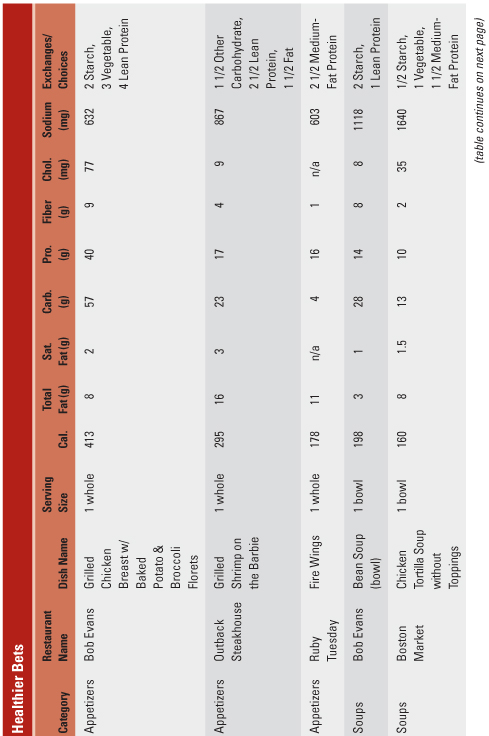

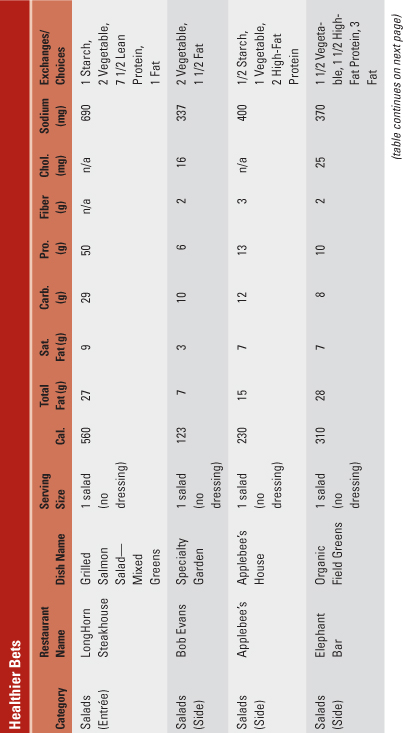


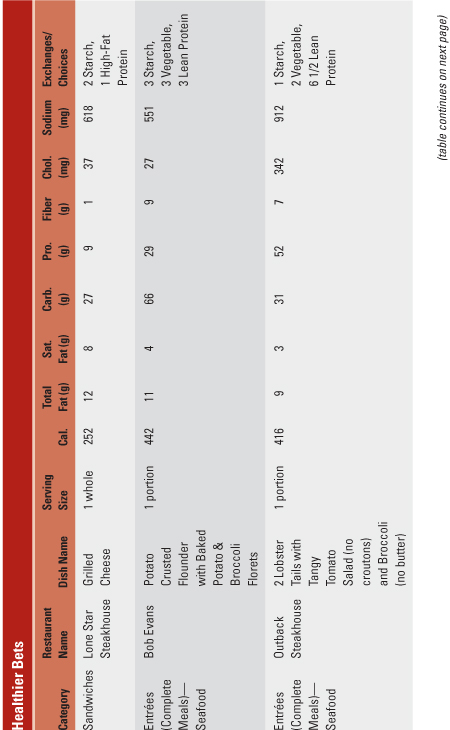




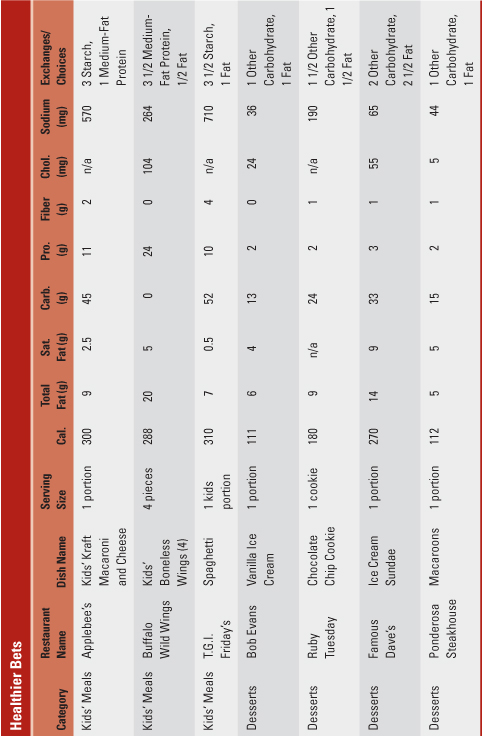
![]() Green-Flag Words
Green-Flag Words
Ingredients:
• BBQ sauce
• Cocktail sauce
• Horseradish
• Jalapeños
• Lettuce, sliced tomatoes, raw onions
• Low-calorie or fat-free salad dressing
• Mustard, honey mustard
• Sautéed onions, peppers, mushrooms
• Spicy Mexican beef or chicken
Cooking Methods/Menu Descriptions:
• Barbecued
• Cajun or blackened
• Charbroiled or grilled
• Marinated
• Marinated in teriyaki sauce
• Mesquite-grilled
• Steamed
• Stir-fried
![]() Red-Flag Words
Red-Flag Words
Ingredients:
• Bacon (strips, crumbled, crisp)
• Blue cheese (crumbled, topped with, salad dressing)
• Butter or cream
• Cheese (grated, melted, topped with, smothered in, sauce)
• Guacamole
• Mayonnaise, garlic mayonnaise, aioli, “special or house” sauce
• Sausage
• Sour cream
Cooking Methods/Menu Descriptions/Names:
• Alfredo
• Battered and fried
• Deep-fried
• Golden fried, crispy fried
• Large, jumbo, piled high, stacked
• Lightly fried
• Loaded or topped with cheese, bacon, or sour cream
• Rolled in bread crumbs and fried or sautéed
• Served in or on crisp tortilla shell
At the Table:
• Butter, margarine
• Mayonnaise
• Sour cream
![]() Healthy Eating Tips and Tactics
Healthy Eating Tips and Tactics
• Decline the bread basket if one is offered. Or, if others want it, keep it beyond your arm’s reach.
• Combine a soup, salad, and side dish or combine an appetizer and a salad for a healthy portion-controlled meal. Hold the entrée and large portions.
• Split everything with your dining partner, from appetizer to dessert.
• Order off the “lighter” menu if there is one. Or create your own lighter fare by limiting high-fat toppings and choosing healthier sides.
• Request a take-home container when you order your meal. Pack up a portion of your meal to take home as soon as your food arrives.
![]() Get It Your Way
Get It Your Way
• Ask for your salad dressing on the side—all of the time.
• Ask that high-fat salad toppers be used lightly or left in the kitchen.
• Request to substitute for high-fat, high-calorie sides with lower-fat, lower-calorie items: substitute a baked potato for french fries or onion rings, request a sandwich on whole-wheat bread rather than on a croissant, or opt for mustard rather than mayonnaise. Each and every change improves the healthiness of your meals.
• Request some lemon or lime slices, vinegar, or soy or teriyaki sauce on the side to flavor menu items without adding tons of calories.
![]() Tips and Tactics for Gluten-Free Eating
Tips and Tactics for Gluten-Free Eating
• Fresh unprocessed meat, poultry, fish, and seafood are naturally gluten-free; however, preparation methods and some processed meats may contaminate these food with gluten.
• Prime rib with au jus may contain gluten, and self-basting turkeys and imitation bacon bits may contain hydrolyzed vegetable protein (HVP) or textured vegetable protein (TVP) and therefore the ingredient label should be checked.
• Avoid all breading, flour dusting, gravies, or stuffing for meats.
• Sauces typically contain gluten. It is safest to avoid sauces.
• Order proteins that have been roasted, grilled, or baked on cleaned surfaces. If necessary, ask that a clean pan be used for preparation.
• Mashed potatoes, hash browns, or other potato dishes may contain gluten if they are made from mixes or are prepackaged. A baked potato or sweet potato is a good choice.
• French fries may be fried in oil that is also used for gluten-containing foods, so they may be contaminated.
• Rice may be prepared in a gluten-containing broth; ask if it is made with only water or if it can be. Brown or wild rice is a good choice if available.
• Plain steamed vegetables with fresh herbs and lemon or a salad without croutons, bacon bits, or gluten-containing salad dressings are good bets.
• If you want or need dessert, opt for fresh fruit, sorbet, ice cream, or frozen yogurt. On the prepared items, ask to check the food and ingredient label to assure that the food is gluten-free. Mention that all you want is the ice cream with nothing else on the side; no cookies or brownies.
![]() Tips and Tactics to Help Kids Eat Healthy
Tips and Tactics to Help Kids Eat Healthy
• Employ the same healthy eating strategies for kids that you use elsewhere (see Chapter 7 for ideas). Have a plan and talk about this plan with your child before you set foot in the restaurant.
• Order wisely. Choose entrées that are grilled, opt for healthier sides like steamed veggies, and avoid high-fat toppings.
• Decline the kids’ menu. Order off the regular menu to expose your child to healthier flavors and ingredients.
• Split portions with your child (or among your children).
• Avoid desserts, which are often offered at a steep discount as part of kids’ menus. If your child tries to negotiate something special, promise a trip to the dollar store. (Go for non-food rewards.)
![]() What’s Your Solution?
What’s Your Solution?
Nearly every Saturday evening, you go out to eat with your family. It’s one of your favorite times of the week because it always feels like a celebration. Your family typically starts with a big appetizer platter and then everyone orders their favorite dish. For years, you’ve been ordering the 9-ounce sirloin with butter sauce and two sides: French fries and cole slaw. It’s only once a week, so this has never seemed like a big deal. But you have recently been diagnosed with type 2 diabetes and you’ve been encouraged to trim off some pounds, so you know that your routine needs some tweaking.
Which of the following healthy eating strategies could you implement?
a) You stay quiet about your strategy. After all, you don’t want to ruin the fun. Just do the best you can.
b) Announce to your family that there will be no longer be any appetizers ordered because you just can’t be tempted by them. Mandate that everyone order off the new “light” menu.
c) Eat just one or two healthier items off the appetizer platter. Order the sirloin, but request that the cream sauce be left in the kitchen (hold the butter sauce). Ask for a baked potato, instead of fries.
d) Share your needs and plan with your family in advance. Get their input. Order a smaller appetizer for everyone to share. Request the sirloin with no sauce, fries, and steamed veggies. Ask the waitperson to bring a take-home container with your meal and put half your meal in it to enjoy tomorrow.
See the end of the chapter for answers.
![]() Menu Samplers
Menu Samplers


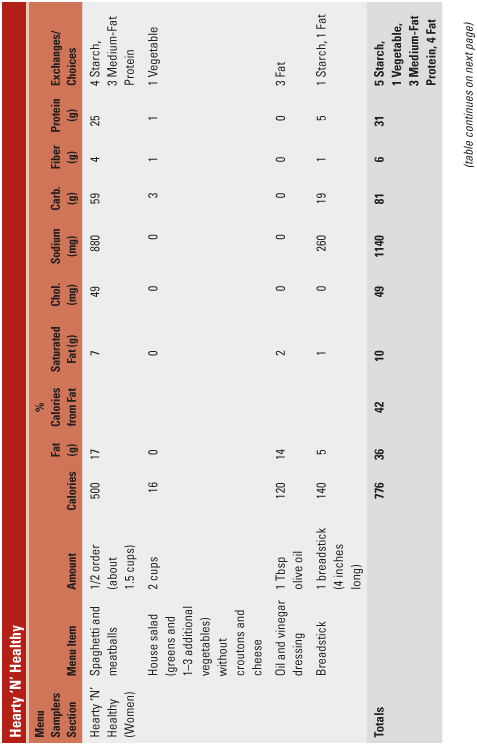



![]() What’s Your Solution? Answers
What’s Your Solution? Answers
a) Every family communicates differently. In general, having
a clear plan, sharing your goals with your family, and sticking to them is an effective way to succeed. Also asking for their buy-in and assistance can help. Do keep in mind that you may have an unwilling family member in your midst.
b) You will likely meet a lot of resistance and won’t be able to sustain this drastic change for long. Try less extreme changes that you and your family can maintain without feeling deprived.
c) This is a healthier option. You are showing portion control with the appetizer, and you’re cutting down fat (and calories) by changing your potato choice and skipping the butter sauce.
d) You’ve got the hang of this! Your whole family is eating healthier by cutting back on calories with a smaller, lighter appetizer. And you saved calories and fat grams by only eating half of your entrée. Allowing yourself fries will help keep you from feeling deprived. Added bonus: you get to enjoy the rest of the sirloin tomorrow in the comfort of your own home and prepared any way you like it . . . perhaps as a steak sandwich or topped on a salad.